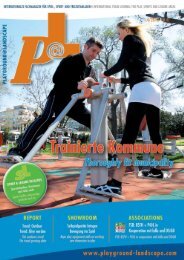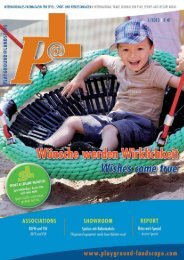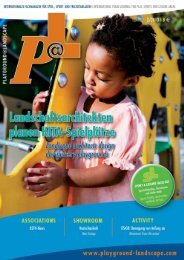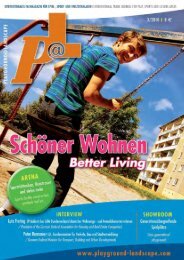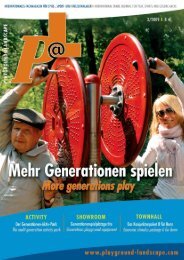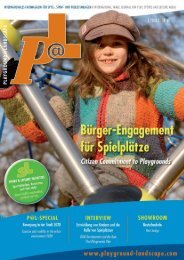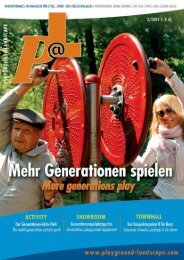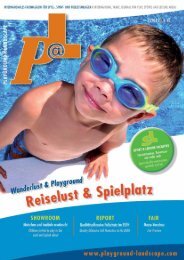School playgrounds - Playground@Landscape
School playgrounds - Playground@Landscape
School playgrounds - Playground@Landscape
Sie wollen auch ein ePaper? Erhöhen Sie die Reichweite Ihrer Titel.
YUMPU macht aus Druck-PDFs automatisch weboptimierte ePaper, die Google liebt.
A ll children enjoy physical play – and this is not just a synonym for<br />
aimless running around and screaming. Through play, they become<br />
bodily active and learn more about themselves and the spatial<br />
and physical nature of their environment. While children explore their<br />
surroundings through play, they can construct an image of the world<br />
around them. They not only take pleasure in their own activities, but<br />
also experiment to find out what they can achieve. A child sitting on<br />
a swing, for example, will carefully try out various body postures to<br />
see how much they can enhance or slow its movements. All the information<br />
passed to the brain is filtered, sorted and emotionally evaluated<br />
in the limbic system. When a challenge is successfully mastered,<br />
the level of the transmitter substance dopamine is elevated and this<br />
leads to a sensation of well-being. This means that someone in the<br />
process of learning something thus becomes eager to learn more.<br />
Child’s play makes you clever. Sport is the source of an exercise-orientated<br />
society. Mental alertness is promoted through physical fitness.<br />
All are concepts endorsed by Professor Renate Zimmer.<br />
“Because of the developing trend towards introducing all-day<br />
schooling in Germany in recent years, it is become particularly<br />
important to ensure that the quality of recreation time in the<br />
playground is adapted to the needs of children and adolescents. In all<br />
educational decision-making, greater emphasis must be placed<br />
in future on the function and significance of the school playground as<br />
a factor determining the healthy physical and mental development<br />
of children,” explains Claudia Gust (SIK-Holzgestaltungs GmbH).<br />
When it comes to designing school <strong>playgrounds</strong>, it is the obligation<br />
of local government and school authorities to ensure not only<br />
that the financial resources are provided, but also that children and<br />
adolescents are actively involved. Participation is the watchword and<br />
research must not be ignored. There are many ways in which active<br />
involvement can be promoted – through such programs as the Ideen-<br />
MachenSchule [Making <strong>School</strong>s Work] project, for example. However,<br />
such projects should have one aspect in common: they need to be<br />
aimed at improving the school environment and facilitating physical<br />
recreational activities. Even the power supplier E.ON Thüringer<br />
Energie recognises the value of such projects and has donated d1000<br />
towards its realisation. So there are other coffers from which it is possible<br />
to obtain funding.<br />
In Nuremburg, the idea of making school <strong>playgrounds</strong> available for<br />
recreation outside school hours is not a recent concept. As early as<br />
1955, the city’s education and culture committee passed the following<br />
resolution: In order to ensure that schools can make a tangi-<br />
COVERSTORY<br />
17



